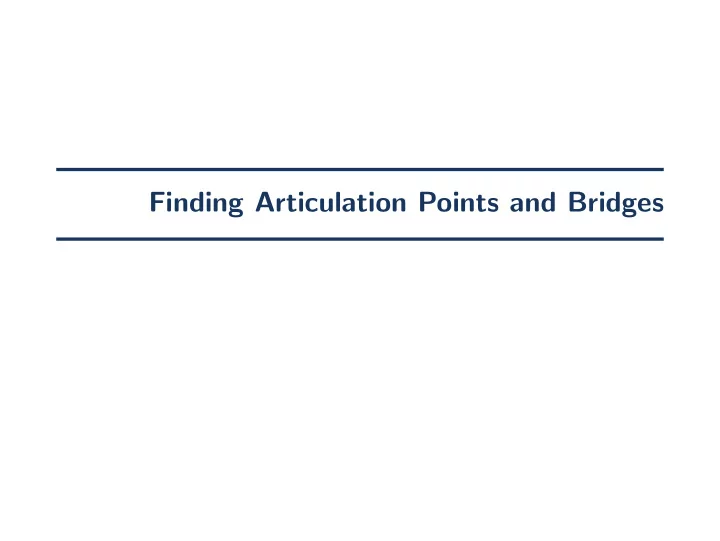

Finding Articulation Points and Bridges
Articulation Points
Articulation Point Articulation Point A vertex v is an articulation point (also called cut vertex ) if removing v increases the number of connected components. A graph with two articulation points. 3 / 1
Articulation Points Given ◮ An undirected, connected graph G = ( V , E ) ◮ A DFS-tree T with the root r Lemma A DFS on an undirected graph does not produce any cross edges. Conclusion ◮ If a descendant u of a vertex v is adjacent to a vertex w , then w is a descendant or ancestor of v . 4 / 1
Removing a Vertex v Assume, we remove a vertex v � = r from the graph. Case 1: v is an articulation point. ◮ There is a descendant u of v which is no longer reachable from r . ◮ Thus, there is no edge from the tree containing u to the tree containing r . Case 2: v is not an articulation point. ◮ All descendants of v are still reachable from r . ◮ Thus, for each descendant u , there is an edge connecting the tree containing u with the tree containing r . 5 / 1
Removing a Vertex v Problem ◮ v might have multiple subtrees, some adjacent to ancestors of v , and some not adjacent. Observation ◮ A subtree is not split further (we only remove v ). Theorem A vertex v is articulation point if and only if v has a child u such that neither u nor any of u ’s descendants are adjacent to an ancestor of v . Question ◮ How do we determine this efficiently for all vertices? 6 / 1
Detecting Descendant-Ancestor Adjacency Lowpoint The lowpoint low ( v ) of a vertex v is the lowest depth of a vertex which is adjacent to v or a descendant of v . Formally, low ( v ) := min { depth ( w ) | w ∈ N [ u ]; u is decendent of v (or equal v ) } Computing low ( v ) for all v ◮ Post-order traversal on DFS-tree T . Theorem A vertex v is an articulation point if and only if v has a child u with low ( u ) ≥ depth ( v ) . 7 / 1
Algorithm 1 Procedure FindArtPoints( v , d ) Set vis ( v ) := Ture , depth ( v ) := d , and low ( v ) := d . 2 For Each u ∈ N ( v ) with 3 If vis ( v ) = False Then 4 FindArtPoints( u , d + 1 ) 5 low ( v ) := min { low ( v ) , low ( u ) } 6 If low ( u ) ≥ depth ( v ) Then 7 v is articulation point. 8 8 / 1
Special Case: Root of DFS-Tree For the root r ◮ low ( u ) ≥ depth ( r ) for all u � = r Theorem The root r is an articulation point if and only if it has at least two children in the DFS-tree. 9 / 1
Bridges
Bridge Bridge An edge is called bridge if removing it from the graph (while keeping the vertices) increases the number of connected components. A graph with a bridge. 11 / 1
Finding Bridges Lemma An edge uv is a bridge if and only if { u , v } is a block. ◮ Use articulation point algorithm to find blocks of size two. Observations ◮ A bridge is part of every spanning tree. ◮ If u is parent of v in a rooted spanning tree, then uv is a bridge if and only if every vertex reachable from v not using u is a descendant of v . Theorem If u is parent of v in a rooted spanning tree, then uv is a bridge if and only if low ( v ) = depth ( u ) and for all children w of v , low ( w ) = depth ( v ) . 12 / 1
Recommend
More recommend